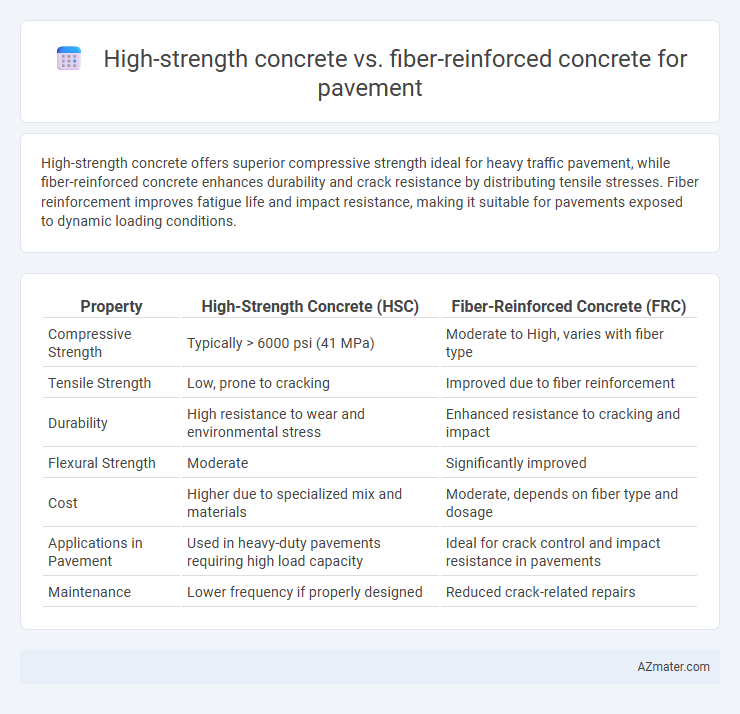High-strength concrete offers superior compressive strength ideal for heavy traffic pavement, while fiber-reinforced concrete enhances durability and crack resistance by distributing tensile stresses. Fiber reinforcement improves fatigue life and impact resistance, making it suitable for pavements exposed to dynamic loading conditions.
Table of Comparison
| Property | High-Strength Concrete (HSC) | Fiber-Reinforced Concrete (FRC) |
|---|---|---|
| Compressive Strength | Typically > 6000 psi (41 MPa) | Moderate to High, varies with fiber type |
| Tensile Strength | Low, prone to cracking | Improved due to fiber reinforcement |
| Durability | High resistance to wear and environmental stress | Enhanced resistance to cracking and impact |
| Flexural Strength | Moderate | Significantly improved |
| Cost | Higher due to specialized mix and materials | Moderate, depends on fiber type and dosage |
| Applications in Pavement | Used in heavy-duty pavements requiring high load capacity | Ideal for crack control and impact resistance in pavements |
| Maintenance | Lower frequency if properly designed | Reduced crack-related repairs |
Introduction to High-Strength and Fiber-Reinforced Concrete
High-strength concrete (HSC) is characterized by a compressive strength exceeding 6,000 psi, offering enhanced durability and load-bearing capacity for pavement applications. Fiber-reinforced concrete (FRC) incorporates discrete fibers such as steel, glass, or synthetic materials to improve tensile strength, crack resistance, and impact durability in pavement structures. Both HSC and FRC contribute significantly to extending the service life of pavements by addressing different mechanical challenges inherent in heavy traffic and environmental stressors.
Material Composition and Key Properties
High-strength concrete for pavement typically features a low water-cement ratio and incorporates silica fume or fly ash to enhance compressive strength above 6000 psi, providing superior durability and load-bearing capacity. Fiber-reinforced concrete integrates synthetic or steel fibers within the mix, significantly improving tensile strength, crack resistance, and impact tolerance, essential for reducing surface deformation and extending pavement lifespan. The choice between these materials depends on project demands: high-strength concrete emphasizes compressive durability, while fiber-reinforced concrete optimizes flexural performance and crack mitigation.
Mechanical Strength Comparison
High-strength concrete exhibits superior compressive strength, typically exceeding 60 MPa, which provides excellent load-bearing capacity for pavement applications. Fiber-reinforced concrete enhances tensile strength and crack resistance by incorporating steel, glass, or synthetic fibers, improving durability under dynamic traffic loads. The combination of fibers in high-strength concrete can optimize mechanical performance, balancing compressive strength and toughness for longer-lasting pavement structures.
Flexural and Tensile Performance
High-strength concrete exhibits superior compressive strength but often lacks adequate flexural and tensile performance needed for pavement applications, leading to potential cracking under load. Fiber-reinforced concrete significantly enhances tensile strength and flexural toughness by distributing stress through embedded fibers such as steel, glass, or synthetic materials. This improvement reduces crack propagation and increases durability, making fiber-reinforced concrete more suitable for pavements subjected to bending and tensile stresses.
Durability and Crack Resistance
High-strength concrete offers exceptional compressive strength, which enhances pavement durability by resisting heavy loads and reducing surface wear. Fiber-reinforced concrete improves crack resistance by distributing tensile stresses through synthetic or steel fibers, effectively controlling shrinkage cracks and increasing impact resistance. Combining these materials can optimize pavement performance by leveraging the high load-bearing capacity of high-strength concrete and the superior crack mitigation properties of fiber reinforcement.
Construction Methods and Workability
High-strength concrete for pavement requires precise batching and controlled curing to achieve desired compressive strength, often involving extended curing periods and careful temperature management to prevent cracking. Fiber-reinforced concrete enhances workability by improving tensile strength and reducing plastic shrinkage, allowing for easier placement and finishing without compromising durability. Construction methods for fiber-reinforced concrete involve incorporating synthetic or steel fibers during mixing, which improves resistance to cracking and enhances overall pavement performance under load.
Cost Analysis and Economic Considerations
High-strength concrete (HSC) entails higher initial material costs due to specialized cementitious components and curing processes, yet offers extended pavement lifespan reducing long-term maintenance expenses. Fiber-reinforced concrete (FRC) incorporates synthetic or steel fibers, increasing upfront costs marginally but significantly enhancing crack resistance, lowering repair frequency and associated economic burdens. Evaluating life-cycle costs reveals FRC can offer better return on investment in high-traffic pavements, while HSC suits contexts prioritizing compressive strength and structural integrity.
Applications in Pavement Engineering
High-strength concrete (HSC) offers superior compressive strength, making it ideal for high-load-bearing pavement sections such as airport runways and heavy traffic highways. Fiber-reinforced concrete (FRC) enhances tensile strength, crack resistance, and durability, which improves pavement longevity in freeze-thaw environments and reduces maintenance costs on urban roads and industrial floors. Combining HSC with fiber reinforcement optimizes structural performance and fatigue resistance, extending service life in demanding pavement engineering applications.
Performance in Harsh Environments
High-strength concrete demonstrates superior compressive strength and durability under heavy traffic loads, making it suitable for pavement in harsh environments with extreme temperature fluctuations. Fiber-reinforced concrete enhances crack resistance and impact toughness, improving longevity in freeze-thaw cycles and abrasive conditions. Combining high-strength properties with fiber reinforcement results in pavements that withstand mechanical stress and environmental degradation effectively.
Recommendations for Pavement Selection
High-strength concrete (HSC) offers superior compressive strength, making it ideal for heavy traffic pavement sections requiring enhanced load-bearing capacity, while fiber-reinforced concrete (FRC) improves crack resistance and durability under dynamic loads, enhancing long-term pavement performance. For pavements subject to frequent heavy loads and requiring minimal thickness, HSC is recommended due to its high modulus of elasticity and reduced maintenance needs. FRC is preferred in pavements needing improved tensile strength, fatigue resistance, and crack control, such as airport runways or industrial floors, where enhanced toughness and durability are critical.

Infographic: High-strength concrete vs Fiber-reinforced concrete for Pavement
 azmater.com
azmater.com